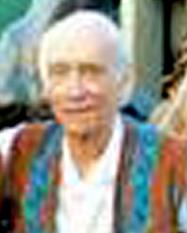
Emerson Hall at the age of 93 (2006)
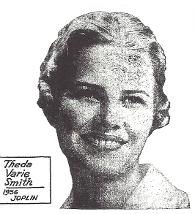
Theda Varie Smith at the age of 20
(1936) 9 years before her marriage to Emerson Hall.
Note: The personal information included in this profile will be somewhat limited, unless I can find relatives of Theda and Emerson to fill in the blanks. However, the couple had no children and some of their close relatives have now passed, so I will do the best with what I have.
William Emerson Hall was born on May 6, 1913 in Portland Oregon and sometime between 1920 and 1929, his family moved to Los Angeles, California. Around 1940 (or shortly before) he opened his photography business at 532 1/2 N. La Brea Ave. in LA.
Theda Varie Smith was born on Jan. 8, 1916 in Fort Worth, Texas. While she was growing up, her family moved a few times - first to Greeley, Oklahoma, then to Shoal Creek, Missouri and finally to Joplin, Missouri. In the late 30s, or possibly 1940, Theda moved to Los Angeles in order to study dress designing. It was there (presumably) that she met Emerson Hall, but unfortunately I do not have any knowledge of their first meeting or when it took place. What I do know is that they were married on May 18, 1945 in New York City. Why in New York City instead of Los Angeles, I do not know.
Back in LA, the couple began working together as a team in their photography business. Most of their work was done in color and appeared on numerous comic book covers, album covers, postcards and calendars. Some of their books of artistic nudes, which were shot in b&w, were published in France in the 1950s.
A few of the album covers that Theda and Emerson shot in the 50s can be seen below:
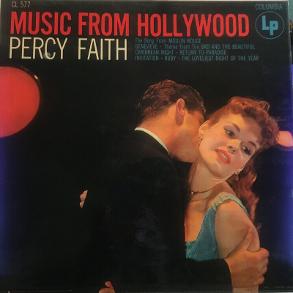
Music From Hollywood - Percy Faith 1954
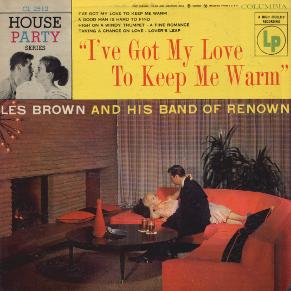
Les Brown and his Band of Renown
1955

Day by Day - Doris Day 1956

Day Dreams - Doris Day 1956
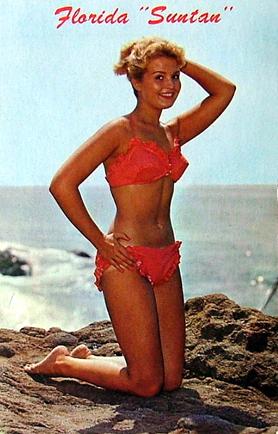
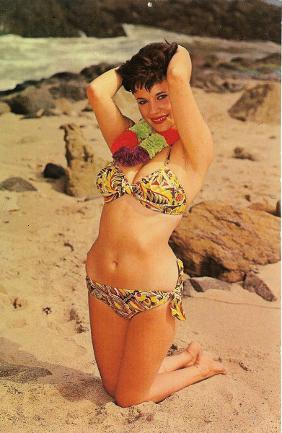
In 1957, the following information was written about Theda and Emerson Hall: "The Halls always work together on every assignment they undertake. Their air-conditioned studio and adjoining home feature the most modern equipment and furnishings. Shooting only color, using electronic flash for all pictures, Theda and Emerson process all photographs in their own studio."
In the mid-50s, while photographing many of their calendar nudes, Theda and Emerson Hall hired the well-known figure and glamour model, Marguerite Empey (Diane Webber). Two of the resulting photos can be seen on this page.
Another popular glamour model who was photographed by the Halls was Jeanmarie Lussier and the couple's cute pin-up of her appeared in the March 1960 issue of Rogue magazine. Also, an unidentified model shot by Theda and Emerson Hall was published in the December 1958 issue of Modern Man magazine (in the Modern Art for Men section). Both images can be seen here.
Sometime in the 1960s, Theda and Emerson undertook a very unusual project - a book of photos with chimps dressed in human attire accompanied by humorous captions. One can only imagine how laborious it was producing such a book and getting the poses you want from the chimps. The book was called Chimp Chat and was published in Japan by the Mitsumura Printing Company.
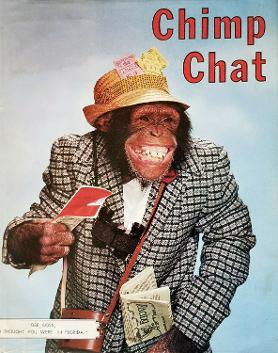
On one of their fishing trips to Montana in 1978, the couple visited the Madison Valley and fell in love with the place. They subsequently bought a small house in the rural community of Ennis, Montana and moved everything from California. In Los Angeles, they had kept working longer than they had to because they loved the photography profession, but now was the time for them to slow down a bit. They still kept active, though, and ran a small business in Ennis.
Theda just adored the place, according to Emerson Hall in a 2006 interview: “Every morning she’d get up and open the drapes and look out at the Madison River and the Madison Range. She just soaked it in.” After 26 years of living in Ennis, Theda Hall passed away on August 7, 2004 at the age of 88. “Our married life was so unbelievable, it will never be matched by anybody ever again,” Emerson said. “I’ll never be happy again as long as I’m alive, but I’m content."
After Theda died, Emerson sold all his guns and fishing gear. He wanted to devote the final years of his life to helping friends and helping Ennis.
To that end, he bought two Steinway pianos for the local school and helped to pay for a project to build a performing arts auditorium, all of which were in Theda’s name. Emerson also donated a larger-than-life sized bronze statue of five wild mustangs to the Ennis schools. The statues — two stallions, two mares and a colt — were especially appropriate for the school, which had mustangs as its mascot. “This is for my wife,” a teary Hall told the crowd as the statue was formally unveiled in a 2006 ceremony.
The next year, on August 13, 2007, William Emerson Hall passed away in Ennis, Montana. He was 94 years old. According to the August 15, 2007 edition of The Montana Standard, Mr. Hall was cremated and no services were held.
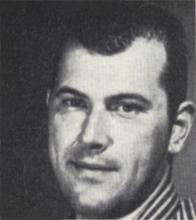
Donald Savage Regas was born on Jan. 13, 1930 in Torrance, California to James Demetrius Regas, a Greek immigrant, and Leora Elizabeth Savage, a native Californian. At the age of 17, Don graduated from Jordan High School in Long Beach and went on to attend Long Beach City College. Later, he enrolled in the Art Center School in Los Angeles to study photography.
In the early 50s, while pursuing his part-time career in photography, Don worked in the lumber business - first as an office manager for Hammond Lumber Company in Long Beach and then later becoming a salesman for the Sun Lumber Co. He continued to work in the lumber industry while having his glamour photos published in national magazines.
A few instances of Don's work being published were in the aforementioned 1959 edition of Best Photography and also in the first issue of the magazine Blondes Brunettes Redheads (1959), which also featured the work of Art Messick, Harry Maxwell and Daryl McCumber. A portfolio of Don's figure photography was published in the Spring 1959 issue of Figure Quarterly and another of his nudes was featured in the May 1959 issue of Modern Man (in the Modern Art for Men section). In addition, Don Regas photographed Kim Taylor for the October 1961 issue of Escapade magazine.
Camera equipment used by Mr. Regas included the Linhof 4 x 5, the Rolleiflex 2 1/4 x 2 1/4 and a Leica (35mm). His film choice for the Rollei was Kodak Verichrome Pan and for the Leica, he used Panatomic X. He developed both films in Microdol. For color work, he preferred Anscochrome because he felt there was less need for color correction. He also preferred outdoor shooting locations rather than working in a studio.
Models photographed by Don Regas included Barbara Harding, Joanne Sommers, Virginia Cooper, Stacey Sands, Colette Andre, Jean Patten, Patti Connelly, Joanie Grant, Patti Powell, Marilyn Wesley, Doris Sanders, Pat Kent and Kim Taylor.
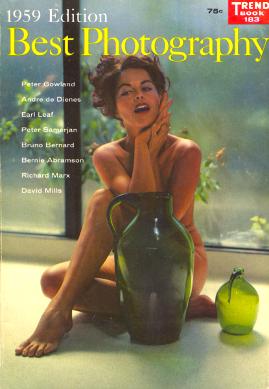
Best Photography (1959) which featured a portfolio of work by Don Regas. Cover photo of Diane Webber by Peter Gowland.
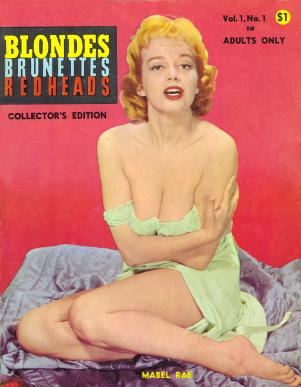
Blondes Brunettes Redheads (1959) featuring Don Regas photos of Marilyn Wesley and Patti Connelly. Cover photo of Mabel Rae by Art Messick.
In the early 60s, Don Regas was accepted as a member of the American Society of Magazine Photographers and he would go on to photograph several magazine covers. Don would also occasionally give talks to some service organizations about working as a professional glamour photographer.
Regarding his personal life, Donald Regas married Dolores Margaret Heller in Feb. 1950 and they stayed married for the next 16 years, before divorcing in July 1966. Don would go on to marry and divorce four more times during the years 1970 to 1985, each marriage lasting just two or three years.
In the early 80s, Don moved to Colorado where he married his 5th wife in 1983. Just four months after that marriage ended in divorce, Don Regas passed away in Colorado Springs, Colorado in November of 1985. He was buried in Evergreen Cemetery in Colorado Springs. Donald Regas was just 55 years old.
If any readers have additional information on this photographer, or are aware of any of the magazines covers that he shot, please let me know.
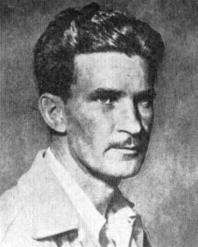
John Henry Howard was born on September 12, 1907 in what would later be known as Tucumcari, New Mexico (New Mexico would not become a state until 1912). His father was a rancher and deputy United States Marshal who had chased such outlaws as Billy the Kid. His father died when Jack was just 18 months old and his mother died when he was five, leaving him an orphan. He spent his early boyhood on a ranch near Dallas, Texas, where he lived with an aunt.
In 1923, Jack became a wanderer and later worked on ranches in West Texas and coal mines in Pennsylvania and West Virginia. In Borger, Texas he worked in the oil fields as a roughneck or driving a T.N.T. wagon. His wanderlust then led him on to the Washington woods, where he worked as a lumberjack. From there he worked as a hardrock miner on the Cascade Tunnel. He worked there until he had saved $1500, then started out again - this time in a Model T Ford. He ended up in Long Beach, California in 1929. After the earthquake of 1933, he left Long Beach and moved to Los Angeles, where he would spend the rest of his life.
Jack had always been interested in graphic art and had studied drawing and painting for a while but gave it up because he thought he had no talent. Golf had been his hobby for several years but because of several operations his doctor had advised him to give up golf and asked him why he didn't take up photography as a hobby. Jack had a friend who was a serious amateur photographer and he traded him golf lessons for photography lessons.
During WWII, Jack worked in a defense plant, helping to manufacture self-sealing gas tanks for Flying Fortresses. All the while, he continued studying photography. In August of 1944, he went to Laguna Beach to enroll in the William Mortensen School of Photography. His first lesson was interrupted by Mortensen's assistant quitting his job, and Jack asked for and obtained his position. He worked with Mortensen until September of 1948 when he left to operate his own studio full time. He soon turned out some remarkable photographs that would be published all over the world. Some of his work had also been exhibited in some of the world's foremost photographic salons.

Figure Photography Annual Volume Four which was illustrated throughout with photos by Jack Howard.
For his camera choice, Jack Howard preferred the Rolleiflex. "Although I have a 4x5 Graflex and a 5x7 Linhof and an Automatic Rolleiflex, I find myself using the Rollie more and the other cameras less," he said. "It is more economical in film cost, the ease of operation is far superior and it has a greater depth of field than larger cameras. Also, the person being photographed is not so apt to be camera conscious."
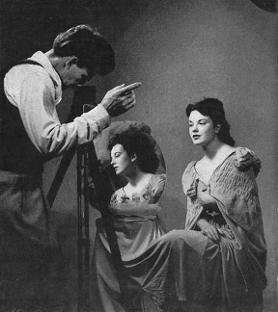
Jack Howard photographing a model using his Rolleiflex.
In terms of illumination, Jack Howard did not demand complicated lighting. In fact, one of his most famous photographs, "Ballet Dancer", was lighted by only a single lamp. "Ballet Dancer" had been exhibited in 25 international salons all over the world and many photographers had asked how it was lighted and were surprised to find that it was illuminated with only a single light. "My answer to their doubts has been that the world has been illuminated by only one light and the sun has been doing a magnificent job of it," Howard said.
When shooting nudes, Jack often used drapes of various fabrics to adorn his models. One of the reasons was described in Volume Four of Figure Photography Annual: "Aside from its use as part of the composition, the drape serves one last function. In most parts of the world we are accustomed to seeing people fully-clothed; therefore, when viewing a full-figure picture of a model sans clothing and props, we become conscious of its starkness. The interjection of a bit of fabric into the scene minimizes the feeling of nudity and places the emphasis where it rightly belongs - on the beauty of graceful lines and the subtle arrangement of grays."
Jack also preferred to use non-professional models but he necessarily relied on some professionals. It was the willingness to assume new personalities, eagerness to take suggestions, and ability to adapt themselves that made him prefer the non-professional model.
As mentioned at the beginning of this profile, I believe that Jack Howard's photographs were rarely printed in magazines past the mid to late 50s, and currently, I have no explanation for this, as Jack did not pass away until February 15, 1987 (in Los Angeles) at age 79. If any readers know what occupied Jack Howard's time during the 1960s, 70s and 80s, please drop me a line so that I may update this write-up on him.
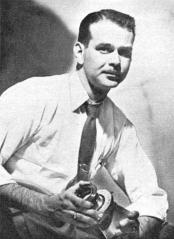
Robert B. Kohl - I first came across the photography of Robert Kohl while perusing such 1950s periodicals as Amateur Art and Camera, Amateur Screen and Photography, Figure, and the men's magazine Modern Man (November 1958 issue, in the Modern Art for Men section). I later discovered articles on Robert Kohl and his wife Helen in the October 1948 issue of Pageant magazine and the September 1949 issue of Popular Photography (he shot the cover of that issue as well). While Robert B. Kohl was a self-described fashion photographer, several of his images could be viewed either as a mixture of fashion and glamour or just plain glamour. In addition, he and his wife would also photograph nudes and those obviously could not be classified as fashion.
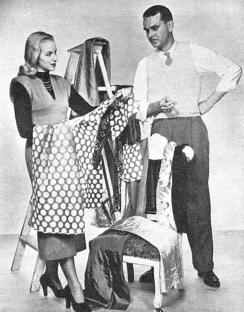
Robert Kohl and his wife Helen, as pictured in the Sept. 1949 issue of Popular Photography.
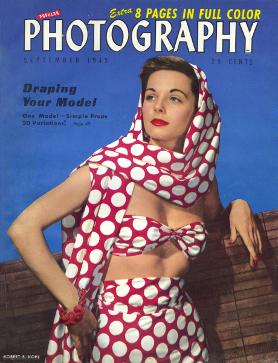
Robert Kohl and his wife Helen created this cover image for the September 1949 issue of Popular Photography. I view this image as a mix of fashion and glamour.
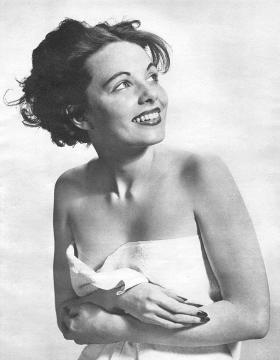
This photo of model Mitzi Proulx was featured in the Kohl's Popular Photography article entitled "Draping Your Model". Since I don't think a simple bath towel constitutes fashion, I look on this image as glamour.
The partnership with George Hukar was dissolved in 1949. George moved to the role of instructor at the Art Center School in California and Bob and his wife moved to Bemidji, Minnesota, where for the next 32 years they owned and operated a large resort (called Kohl's Last Resort). One obvious question that I have is whether all of their published work in the 1950s was just photos they had taken in the mid to late 40s, or if while running their resort in Minnesota, they had time to do occasional photo shoots. I have contacted their daughter Kristin regarding this question, but have not yet heard back from her.
The work that was published in the 50s included some nudes, and a few of the magazines in which their photography appeared include:
Art Photography (July 1950) - The Kohls photographed the model on the cover.
Glamorous Models (July 1950) - Eight pages of models from Illinois (including a Miss Illinois) that were photographed by Robert B. Kohl.
Glamorous Models (September 1950) - Several photos credited to Robert B. Kohl appear in this issue.
Glamorous Models (July 1951) - Pages 14-15, 18-19 and 30-35.
Cover Girls Models (August 1951) - Two pages of bikini-clad Chicago model Jane Casey.
Glamorous Models (September 1951) - Pages 8-9 and pages 42-43.
Cover Girls Models (April 1952) - Another article on "Draping a Model".
Cover Girls Models (June 1952) - a page featuring Robert B. Kohl's model Mitzi Proulx.
Amateur Art and Camera (Sept. 1952) - An artistic nude on page 28.
Figure (No. 21 - mid 50s) - Four nudes on pages 8 and 9.
Amateur Screen and Photography (Oct. 1954) - Bob and Helen shot the cover image and had an article published inside the magazine.
Figure Quarterly (Volume 10 - 1955) - Robert B. Kohl wrote a 6 page article that featured the nudes of several photographers (including one of his own as well as the works of Bruno Bernard, Andre de Dienes and Joan Craven). The article was titled "The Charm of Simplicity".
Amateur Screen and Photography (Vol. 13 No. 3 - unknown date) - An article entitled Staccato!
Modern Man (June 1957) - Robert Kohl had a nude published in the Modern Art for Men section of the magazine.
Modern Man (Nov. 1958) - Two separate nudes by the Kohls were featured in the Modern Art for Men section.

The Oct. 1954 issue of Amateur Screen and Photography which featured a cover image by Bob and Helen Kohl as well as an article inside the magazine.
In addition to running a resort on Big Turtle Lake in Minnesota, the Kohls also raised three children - Rex, Kurt and Kristin. Bob also found time to become a lobbyist for the tourism industry in Minnesota and served as president for several resort associations. He also served on the Advisory Council of the Small Business Administration in Minnesota, was a radio announcer and editorialist at KBUN Radio in Bemidji and was a writer with numerous published works, including many industry publications. By 1980, Rex and Kurt Kohl had taken over the resort from their parents.
In 1981, Bob and Helen moved to southwestern Utah. There, Bob initiated development plans for the Southwest Indian Museum, for which land had been allotted in Ivins, Utah. His fondest wish was to be present at the ground breaking ceremonies. Bob was a public speaker for the Utah Humanities Council, was a charter member and past president of the Jennifer Jack Chapter of the Utah Statewide Archeological Society, member and past president of Dixie Masonic Social Club, member of Scottish Rite of Free Masonry and Shrine, Master Mason of St. George Lodge #33 and 45-year member of BPO Elks.
Another important connection that Robert Kohl had to the field of glamour and illustrated pinups was revealed on February 10, 1998, when Bob wrote a letter to Charles G. Martignette, a pinup collector from Hallandale, Florida. While it was long rumored that Chicago pinup artist George Petty used only his wife and his daughter Marjorie as models for his pinup illustrations, Robert Kohl finally set the record straight. He wrote:
"I have in my possession 45 black and white 5x7's and 8x10's of the real nude model, and a number of tear sheets from Esquire and True magazines, showing the relationship of the artist/copy photos and finished/published artwork.
During the studio years I had occasion to visit with Petty and on at least one occasion with his daughter Marjorie, while shooting his long-time model. I assisted in the making of some of the photographs. One of the shots shows partner Hukar holding the elevated foot of the model, with Marjorie holding the typical contorted hand of the model favored by Petty.
Actually, Hukar had photographed the same model for years for Petty. Petty would call George and the model, who originally lived in Chicago, and arrived for studio time at off-hours to avoid any unwanted interruption or publicity. It became more difficult for Petty to make arrangements when the model moved to Indianapolis. I also believe that the model became less enchanted with the anonymous glamor of being a Petty model, with the train trips to Chicago, and the minimum fee and expense paid by Petty. Further, the model married in Indianapolis and may have run into some marital objections.
Two facts should be noted: First, to the best of my knowledge, Marjorie Petty never posed for any artist copy pix by George Hukar [or me], nor had her mother ever been photographed by Hukar for that purpose. Second, Petty did not paint from life, and this was his most jealously guarded secret."
Robert Kohl did not know the name of the George Petty model, as it continued to be a closely held secret among the Petty family.
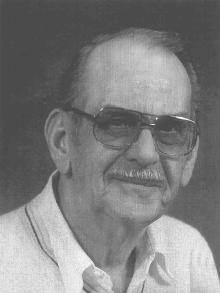
Robert B. Kohl in his later years.
Update (2/18/23): Robert Kohl's wife Helen passed away just 4 months ago (October 12, 2022) at the age of 100 years and 2 months. The year after Bob Kohl died, Helen moved back to Bemidji, MN where she would later meet a widower by the name of Chet Swedmark. The two exchanged commitment vows on August 23, 2003 and stayed together until Chet's death in 2011. To read a story from the Bemidji Pioneer about Helen's 100th birthday celebration, click here.
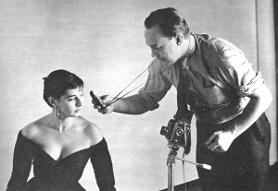
New York photographer Burt Owen takes a meter reading of Italian beauty Maya Denise during a photo shoot (circa 1956).
Burt Owen - Burt Owen was a New York photographer who shot a variety of subjects, including musicians (Louis Armstrong) and sports figures (Whitey Ford), but he also shot quite a few magazine and album covers and contributed to some books and magazines that were related to the field of glamour photography. A few of the glamour-oriented magazines that published his work were Charm Photography (No. 5) 1956 and Photo Arts (The Nude on Film) Vol. 1, No. 6. He also wrote a chapter for the 1959 Whitestone book "The Technique of Figure Photography" which was illustrated with many of his photos.
Burt Owen was born on February 5, 1919 in Bridgeport, Connecticut but spent some of his formative years living in London. He returned to the U.S. in 1940 and served in the Signal Corps. He later became assistant to a photographic illustrator, and then worked in a New York catalog house where technique was all-important. By 1953, he was working in his own studio at 36 Central Park South. He would move studio locations a few different times, first to 235 E 60th Street, and then finally to 135 Madison Avenue.
During the early to mid 50s, Burt would photograph famous trumpeter and singer Louis Armstrong and one of his photos would be used on the cover of the book "Satchmo - My Life in New Orleans" in 1954. Another of his images of Armstrong appeared on the album cover for "Satch plays Fats" in 1955.
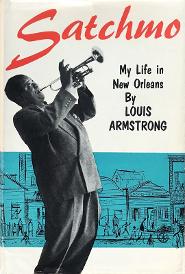
Burt Owen shot the cover image of Louis Armstrong for the book "Satchmo" (1954)
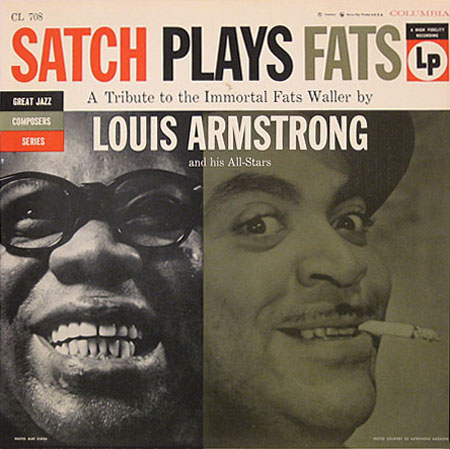
The image of Armstrong on the album cover for "Satch plays Fats" (1955) was taken by Burt Owen.
In 1956, seventeen pages of Burt Owen's stylistic photos of women (including three nudes) would be featured in Charm Photography No. 5. One of the photos can be seen here. He later penned a chapter of the book "The Technique of Figure Photography" in 1959 which featured 14 pages of his photos.
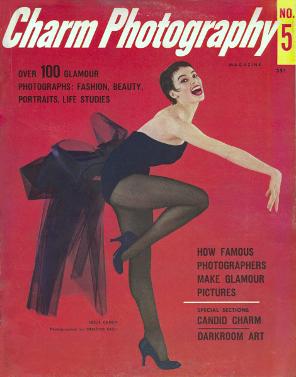
Charm Photography No. 5 (1956) which features seventeen photos by Burt Owen.
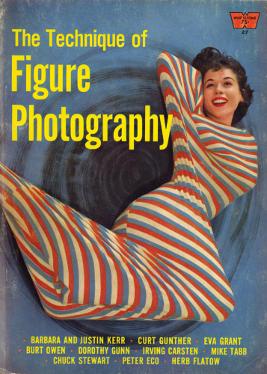
14 pages of Burt Owen photos appeared in the 1959 book "The Technique of Figure Photography".
Some of Mr. Owen's non-nude models included Carol Tobey, Inka Falk, Brooke Robin, Dorothy Rice, Tere Dennis, Anita Colby, Dorothy Rowand, Cheri Kirk, Germaine Blondel, Maya Denise, Simon McQueen and Janet Burgess. His nude models were usually unnamed.
Regarding selection of models, he wrote: "Anyone and everyone is a possible model. If the photographer is interested in a particular person as a photographic subject and has the technical, artistic and psychological facilities at his command, then he may have a very successful sitting, regardless of whether his subject is a professional or amateur."
On his preferred lighting, Mr. Owen opined: "Nothing can compare with nature's own light for the finest and most realistic effects. I like to use daylight both indoors and out as much as possible. If the use of natural light is impractical, my next choice is strobe."
About his camera equipment: "I use cameras of all sizes, from 35mm to 8x10. Certain jobs call for certain sizes and formats. It would be most convenient if one could do everything on 35mm or No. 120 film, and I suppose everything could, but in some cases not as well as on a larger plate camera. Cameras of all sizes are made and sold, so there must be a good reason for the wide variation. My favorite is the 35mm and next to that, I enjoy using a big 4x5 Graflex that makes a lot of clanks and other noises when in operation."
Concerning darkroom work in general, he wrote: "It is just one more complicated facet in the art of photography and it is one which ties up and completes all the work that has gone before to produce that final print that will be a joy to behold and a credit to the hard-working photographer."
Of all of Burt Owen's magazine cover shoots, perhaps his most steady gig was for the Dell magazine called Inside Detective. The largest number of Inside Detective covers from 1957 to 1961 were photographed by Burt Owen. He also shot at least one photo for the cover of a men's magazine - the October 1962 issue of Gent. On the opposite end of the spectrum, he also shot a few covers for Woman's Day magazine!
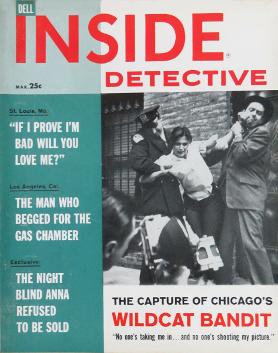
The March 1960 issue of Inside Detective magazine. The cover photo was shot by Burt Owen.

Burt Owen shot this cover photo for the October 1962 issue of Gent magazine.
A few of Burt Owen's album covers included Dorothy Collins' "At Home with Dorothy and Raymond" from 1957 and a posthumous use of his photo of The Weavers was used for the album "Weavers Classics" (1985).
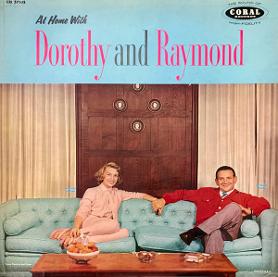
Dorothy Collins' 1957 LP "At Home with Dorothy and Raymond" features a cover shot by Burt Owen.
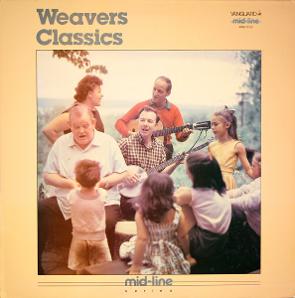
A photo of The Weavers that was taken by Burt Owen was used for the cover of "Weavers Classics" (1985).
Mr. Owen's photographic work seemed to be much in demand in the early 60s, but I have found two newspaper articles that mentioned him also having a second job as a salesman. I don't know for sure if this is true or not.
Sadly, Burt Owen's success in the field of photography came to a tragic end in the early morning hours of August 28, 1964. He was driving his small foreign-made car on a Route 6 detour near Westport, Massachusetts (headed east toward Provincetown, Cape Cod to rejoin his family - he and his wife had at least two children) when a drunk driver crossed the center line and hit his car head-on. He was taken to St. Ann's Hospital in Fall River where he was pronounced dead on arrival. He was just 45 years old.
Note: Complicating my research for this profile on New York photographer Burt Owen was the fact that there was another photographer by that name who lived on the West Coast. Burt and Katie Owen were photographers who initially lived in Laguna Beach, California but moved to Anaheim in the early 50s. They shot some glamour and nudes and sold a lot of photos to calendar companies. I had mistakenly attributed one of their nudes (which appeared in the Winter 1960 edition of Modern Man Quarterly) to New York's Burt Owen. I have since corrected that error.
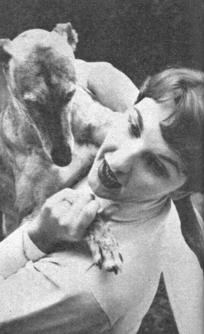
Christa (Zinner) - Christa, an L.A. photographer who only went by her first name, shot photos of movie stars and celebrities such as Elizabeth Taylor, Lauren Bacall, Katherine Hepburn, Grace Kelly, Judy Garland, Fred Astaire, Ronald Reagan, and Cher. During the 1950s, she also shot images that appeared in some glamour-oriented magazines such as Famous Models (September-October 1951), Gala (June 1951), and Charm Photography (1955). A few of the glamour models that she photographed included Irish McCalla and Mara Lynn. As I was curious about this photographer with one name, I sought out more information about her life and career.
Christa was born in Hanover, Germany on July 10, 1920 as Christa Ruth Heutelbeck. When she was a 16-year-old student, she traveled to the U.S. and stayed for more than a year before returning home to her family in Germany. Two years later and newly married, she returned to the U.S. with her husband and settled in Oregon. Unsatisfied with the limited opportunities in rural Oregon, she divorced and moved to San Francisco where she worked as a fashion model. She soon discovered, however, that she preferred working on the other side of the camera. While in San Francisco, she managed a studio and developed her skills taking portraits of war brides and sweethearts of soldiers overseas. In the early 1940s, Christa moved to Los Angeles where she purchased a Rolleiflex camera and enrolled as a student in the Art Center School. Her sense of composition and arrangement improved so remarkably that she later became an instructor at the school.
By the mid 40s, Christa was working as a free-lance photographer in Los Angeles and her photos would appear in numerous magazines and were also featured on the covers of Life, Look, Vogue, Ebony, Glamour, Town & Country, and Sports Illustrated.
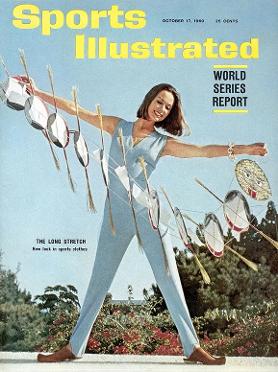
The October 17, 1960 issue of Sports Illustrated with a cover shot by Christa.
"In photography", Christa was quoted as saying in 1955, "there seems to be no way to escape the full experience of joy and satisfaction, disappointment and frustration. I know of no miracle-evoking rules, no do's and don'ts which can solve the utter subjectivity of making pictures."
On photographing models in general, she said "For me, photography is a decidedly personal matter. I choose my models with great care. I work preferably with natural situations and natural light, leaving many of the decisions to the inspiration of the moment. I find that to adhere to any one method is to limit oneself. The danger exists, naturally, in everyone's career, if for no other reason than it's a path of least resistance."
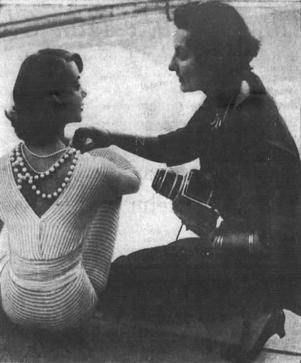
Photographer Christa seen working with fashion model Sue Brown
(circa 1957).
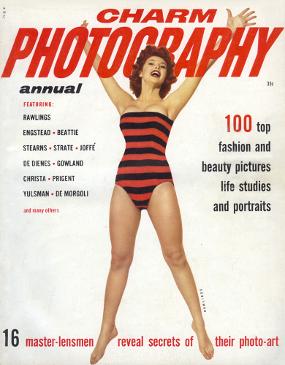
Charm Photography (1955) featuring photos by photographer Christa. Cover image by John Rawlings.
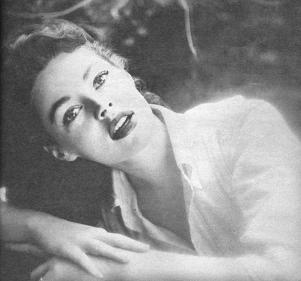
RKO starlet Barbara Darrow photographed by Christa and published in the 1955 issue of Charm Photography.
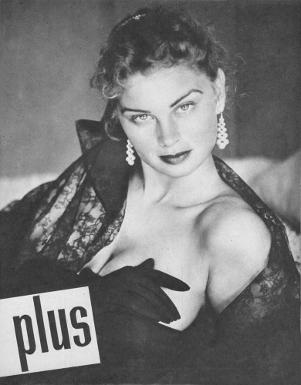
Irish McCalla photographed by Christa - from the September/October 1951 issue of Famous Models.
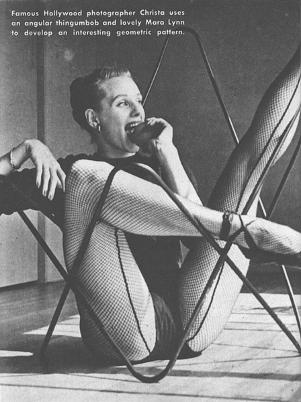
Mara Lynn as captured by Christa and featured in the June 1951 issue of Gala magazine.
In the 1955 issue of Charm Photography, it was noted that Christa's preoccupation with photography was only matched by one other activity - her love of fancy food dishes which she prepares with culinary skill. In the kitchen she "restores my run-down battery" and there her "activities hold a more immediate reward."
In 1961, Peter and Christa would welcome a daughter, Katina Zinner, who would later become an editor, producer and painter. Christa also had a son in 1955 (from a previous marriage): Nicolas Nelken, who became a vascular surgeon.
By the early 70s, according to www.christazinner.net, "Christa Zinner's focus began to shift from capturing to creating images. She studied live drawing in Rome, Italy and at the age of 70, fulfilled a lifelong dream and blossomed into a talented sculptor. "After years of seeing the height of fashion through a camera lens," says Christa, "I am still fascinated by the human form. Sculpting fulfills my artistic visions in a new and very palpable way." Her classic busts of unique personalities and lifelike bronze nudes capture moments of human pondering, consternation and bliss."
Christa's husband Peter Zinner died on November 13, 2007, at age 88, in Santa Monica, California, from non-Hodgkin lymphoma. After his death, Christa continued to work as a sculptor and at some point she would live with her daughter, Katina Zinner. Christa Zinner passed away in Los Angeles in March of 2013 at the age of 92. To read about the diverse relationships Katina had with both her parents (Peter and Christa) as well as her artistic endeavors, check out https://www.katinazinner.com/biography.html
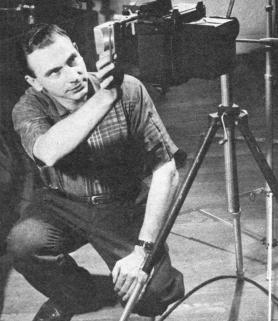
Douglas Grundy - When I first saw the photos of Douglas Grundy in the mid- 50s editions of photo books such as Salon Photography, Good Photography and Prize Winning Photography back in 2008 or so, I made several assumptions about the photographer. I assumed that he was a native New York photographer who had operated a studio for many years. I was certainly impressed by the creativity he expressed in his work, some of which can be viewed on this page. It was just this year, 2022, that I learned more about Douglas Grundy's life and I was definitely surprised by what I found. After digging a little deeper, I uncovered some information about his character that was quite disappointing (to say the least).
Douglas Bertram Grundy was born on July 21, 1921 in Surrey, England. As a young man, he studied architecture in Germany but by 1938, he realized that war was imminent so he left Berlin for London and enlisted in the R.A.F. His flying experiences, however, came to an abrupt end in November 1941 when the night bomber on which he was a navigator was shot down over East Prussia. For the next 3 1/2 years, he was a prisoner of war. As a prisoner, he read many books on photography and also got to know hundreds of Americans who were fellow prisoners. Following his release, he remained on the Continent for another year as an interpreter at military conferences in Berlin, Hamburg and Kiel.
Mr. Grundy's first photographic job was in Montreal, Canada, where he worked for a fashion studio in 1949. Moving to New York City the next year, he soon drew varied photographic assignments and later opened his own studio in Greenwich Village. On magazine assignments, he shot just about anything, but his favorite subjects were architecture and glamour. He also got to photograph several actresses, actors and other celebrities, such as Judy Holliday, Rita Gam, Don Ameche, Rod Steiger, Joe DiMaggio, and Jayne Mansfield (Caper magazine, January 1957).
In 1955, Grundy was quoted as saying "To me a picture is always a design. Background pattern and color should all blend into a harmonious whole. With my architectural training, I am fascinated by lines and curves, and I feel that a strong welding of the two in a picture increases its impact. I prefer to work on subjects that provide a challenge and need thought in preparation. Inexperienced models tend to slow down the process of shooting. Experienced models help give me a sense of direction." He continued, "I like to experiment with creative backgrounds, painting them myself, as this seems to be a way to avoid pictorial cliches."
Douglas Grundy seemed to have reached the peak of his popularity (at least as far as magazine and book publication goes) during the years 1954 to 1956, with his photos appearing in the following periodicals:
Good Photography (1954) - page 108, "Relaxing Nude".
Prize Winning Photography (1954) - page 19, "Nude Torso"; page 112, "Figure Study"; page 118, "Ballerina Study".
Charm Photography (1955) - three of his photos were featured, including the above-mentioned "Ballerina Study".
Prize Winning Photography (1955) - page 22, "Seated Figure"; page 60, "Rita Gam portrait"; page 112, "Modern Nude"; page 119, "Girls Sunning"; pages 134 & 135, "Pat".
Art Photography (December 1955) - an article entitled "Shadowgrams", which was illustrated with several of his nudes.
Classic Photography (Autumn 1956) - "Grundy's Aquarium", with several photos showing a nude model appearing to swim in an ordinary fish tank.
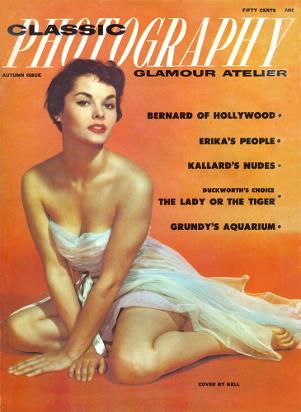
Good Photography (1956) - pages 66 to 71, an article called "Shooting Down" which features photos of ice skaters taken from a high angle; pages 74 & 75, "Judy [Holliday] and Friend"; page 78, "The Big Bawl" (child crying); page 136, "Stripes" (Blonde Model).
Salon Photography (1956) - pages 18 to 23, "Figure in a Frame"; page 70, "Parachute Tower"; page 130, "Blonde".
It was also in 1956 that a story about Douglas Grundy's turbulent personal life made it into newspapers across the U.S. and also in at least one newspaper in England, which may have contributed to the downfall of his photography career. Mr. Grundy was charged with beating his 18-year-old beauty contestant wife during a party that was meant to celebrate her being crowned Miss New York State. Below is one of the articles that was published on July 10, 1956.
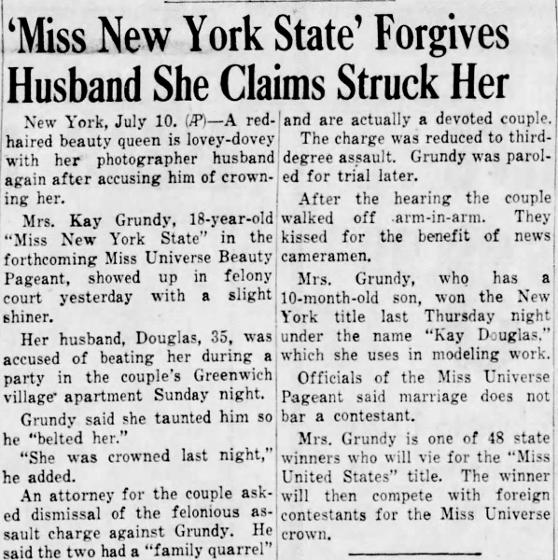
Less than two months later, Kay Grundy got in trouble with the law herself for stealing a man's dog.
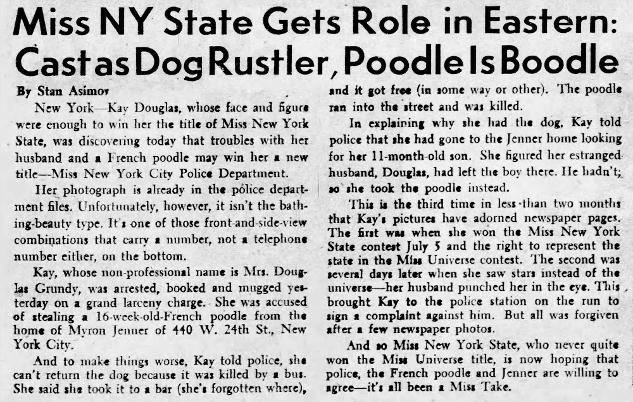
In March or April of 1957, Douglas Grundy left the U.S. (and his once flourishing New York photography career) with his wife and son and returned to England. On January 24, 1958, a story appeared in the Bay Ridge Home Reporter (Brooklyn, NY) about the final breakup of the couple's marriage.

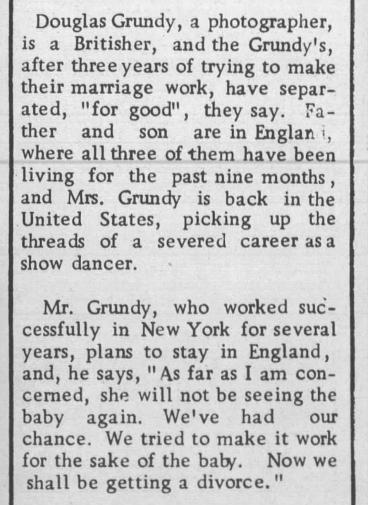
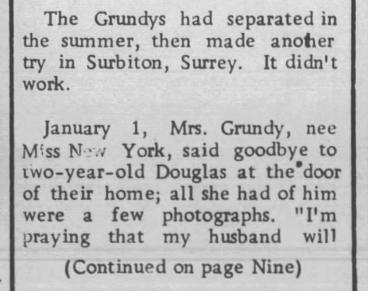

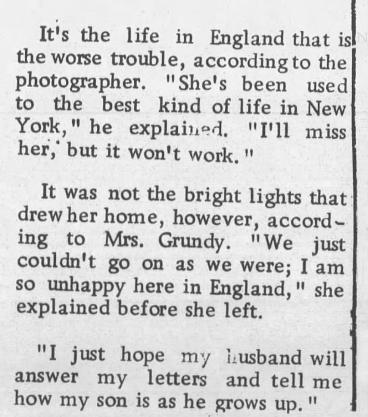
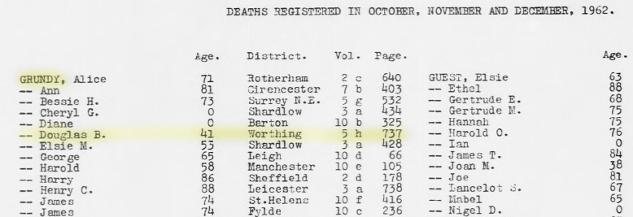
Douglas Grundy was just 41 years of age at the time of his death. I'm wondering what happened to the young son. Perhaps Mr. Grundy sent the child back to the U.S. sometime before he took his trip to South Africa. More research is needed.
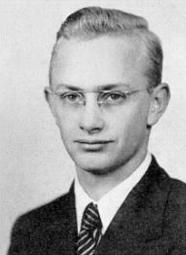
A high school portrait of Virgil Buss that was taken in 1942 or 43.
Virgil Junior Buss was born in Bowen, Illinois on February 19, 1924 to John and Lillie McClain Buss. He would become the oldest of four children - he had one sister and two little brothers. When he was just out of high school (1943), he was inducted into the U.S. Army. After his discharge, Virgil Buss obtained employment in the Los Angeles area where he worked as part of the ground crew for United Airlines, and later, Continental Airlines. In the early to mid-50s, while working for the airline, Virgil moved to the community of Redondo Beach (in the section known as the Hollywood Riviera). Although I don't know when Virgil Buss first became interested in photography, it appears that he began photographing models in his home at 1907 Camino de la Costa in Redondo Beach in the mid to late 50s. As mentioned previously, some of his first photos of model Virginia Gordon were published in the Volume 1, Number 1 issue of Spice magazine (1959). And while Virgil's photos would initially appear in the Modern Art for Men section of Modern Man, by 1963 he was shooting covers for the magazine as well as the Uncovered Cover Girl pictorial inside (June 1963 and August 1963), this time using his real name - Virgil Buss.
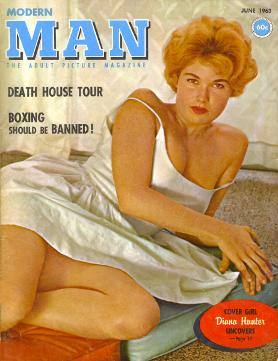
Virgil Buss photographed model Diana Hunter for the cover (and pictorial inside) the June 1963 issue of Modern Man.
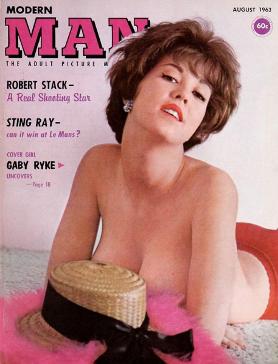
Gaby Ryke (also known as Gaby Martine) on the cover of the August 1963 issue of Modern Man. Virgil Buss photographed the cover as well as her layout inside the magazine.
Several of Virgil Buss's contributions to Modern Man include:
August 1960 - two of Virgil's photos (as Virgil Buzz) were featured in the Modern Art for Men section of the magazine. The models were Diane Michaels and Corrie Amsterdam.
October 1960 - another photo of model Corrie Amsterdam appeared in the Modern Art for Men gallery.
March 1961 - a very nice artistic image of Virginia Gordon appeared in the Modern Art for Men gallery.
July 1961 - a photo of Virginia Gordon was published in the Modern Art for Men gallery.
May 1963 - a full page color photo of Virginia Gordon appeared in the Modern Art for Men gallery.
June 1963 - Virgil's photos of "Uncovered Cover Girl" Diana Hunter were featured inside the magazine.
August 1963 - "Uncovered Cover Girl" Gaby Ryke, a British model who also went by the name Gaby Martine (as well as a few other names).
December 1963 - model Carol Shipley in the Modern Art for Men gallery.
June 1964 - another studio shot of Virginia Gordon in the Modern Art for Men section of the magazine.
July 1964 - Virginia Gordon in the Modern Art for Men section.
August 1964 - Virginia Gordon in Modern Art for Men.
September 1965 - Virginia Gordon in the Modern Art for Men section.
Beau magazine (an international version of Modern Man that was printed in England) - August 1966 - Virginia Gordon in the Modern Art for Men section. This section was a duplicate of the gallery that was published in the August 1964 issue of Modern Man.
In addition to having his work published in the magazines Spice and Modern Man, Virgil Buss also contributed photos to the nudist publications Paradise Quarterly (1962 to 1965 - the first 9 issues) and Eden Quarterly (Spring 1965).

The first issue of Spice magazine (1959) featuring eight photos of Virginia Gordon by Virgil Buss.

Paradise Number 6 (1964), a nudist magazine which listed Virgil Buss as one of its photographic contributors.
For his black and white work, Virgil usually used his Rolleiflex (medium format camera) which was often loaded with Verichrome Pan film.
At some point in the mid-60s, Virgil seemed to have stopped submitting his glamour and nude photos for publication in magazines and books.
According to his obituary, Virgil J. Buss retired from his job with Continental Airlines in 1986 at the age of 62. In 1991, he moved to Tucson, Arizona to be closer to his mother Lillie and brother Leo, who by that time were living in the city.
Virgil Junior Buss passed away on Sept. 12, 1991 at St. Mary's Hospital in Tucson. His body was taken back to his home state of Illinois and was buried in Swan Lake Memory Gardens in Peoria. Virgil Buss was 67 years of age at the time of his death.
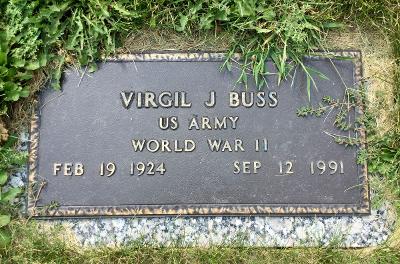
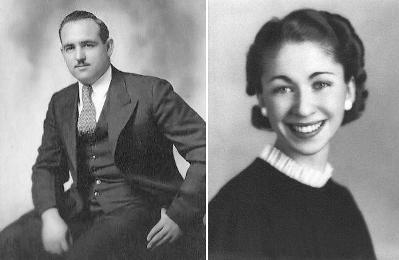
Katie and Burt Owen - I only learned of this husband and wife team from Southern California when I saw one of their nudes in the Winter 1960 edition of Modern Man Quarterly (in the Modern Art for Men section). I originally mistook the photo as the work of New York's Burt Owen (also profiled on this page), but with a little more research, I found that there were two Burt Owens who had made photography their career - one in New York and the other in California.
Both Katie and Burt were originally from small towns in Iowa. Perry Burton "Burt" Owen was born in Clarinda, Iowa on March 29, 1910 and Katherine Margaret "Katie" Bening was born in nearby Shambaugh on March 5, 1911. They both attended Clarinda High School which was likely where they met.
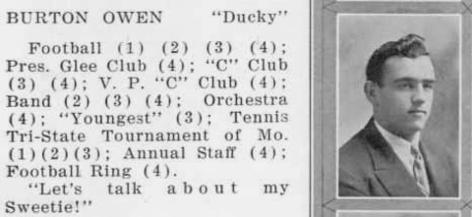
Photos of Burt and Katie from the 1928 Clarinda High School Yearbook.
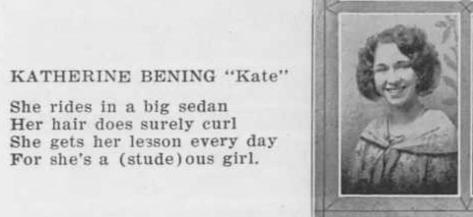
Burt's father, Perry Wilbur Owen, owned and operated a bakery shop in Clarinda (Owen Bakery & Cafe) and Burt worked in the shop with his father. On Christmas Day of 1929, Burt and Katie were married at Katie's home in Shambaugh and the new bride soon moved in with Burt and his father. Burt's mother, Belle, had passed away eight months earlier due to a stroke. In April of 1931, Burt's father, age 58, also passed away. The next tidbit of information that I could find was that by 1940 the couple had moved to Saint Joseph, Missouri where Burt worked for the Rainbo Bakery Company. At some point in the early to mid 40s, Burt and Katie moved to Baldwin Park, California (a suburb of Los Angeles) and later to Garden Grove and Laguna Beach. It was at these latter two locations where the couple started gaining a reputation for their photography. In fact, a newspaper article from 1952 proclaimed: "The Owens have the distinction of having the first and only exhibit of photographs ever to be accepted by the famous Laguna Beach Art Gallery. Forty-five of their magnificent photographic masterpieces were hung in Moulton Hall as one of the featured exhibits. This was due to their unique artistry and the naturalness and beauty of their work."
In 1952, the couple moved from Laguna Beach to Anaheim and would also have their work exhibited there, as well as in Long Beach and a few other cities. They gained recognition for their character studies, pinups and children's pictures. A few of their subjects included motion picture star Linda Darnell and model Priscilla Orman (from Anaheim). Katie and Burt Owen sold their pinups to various calendar companies (including the Shaw-Barton Calendar Company in Coshocton, Ohio) and a few of their models would later enter the Miss California USA pageant. In 1953 the Owens urged their model Sandra Constance of Torrance to enter the contest and she emerged as the state winner. The next year, the couple repeated the process with another of their models, Donna Schurr (of Garden Grove), who also went on to win the Miss California title! In 1955 the photographers groomed yet another of their calendar and cover models, Darlene Hendricks (an aspiring actress), for the title, but unfortunately she did not win, thus breaking the couple's streak.
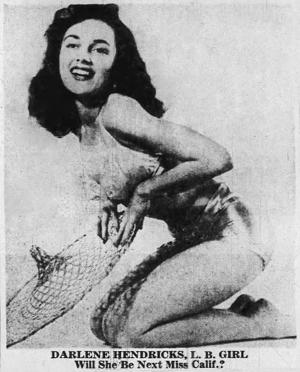
Darlene Hendricks, a pinup model from Long Beach who entered the Miss California USA contest in 1955.
Photo by Katie and Burt Owen.
In addition to being photographed by the Owens, Miss Hendricks would pose for renowned glamour photog Peter Gowland. His photos of her and two other models were featured in a pictorial entitled "Three Girls and a Coat" in the April 1955 issue of Pageant magazine. Darlene also went on to act in a few movies during the late 50s and early 60s (Note: Deloris Darlene Hendricks, whose married name was Darlene Moody, passed away on Nov. 29, 2018 at the age of 84).
Another beauty contestant who had been photographed by the Owens was Carole Higginbotham, a high school student and professional ice skater from Venice, California. Miss Higginbotham entered several local beauty contests in 1955 and it was at the Huntington Beach contest where she caught the eye of Burt and Katie Owen. Carole made several trips to Anaheim to work with the couple, who shot about a dozen color transparencies of her to send to the New York calendar market. Burt estimated that at least half of the photos would be sold and appear on calendars a few years later. Another of the contests Carole had entered was the Venice Surfestival Bathing Beauty Contest of 1955 where Peter Gowland was the head judge. Miss Higginbotham was invited to work with Gowland and she soon began attending a modeling school in Culver City. Although Carole's 5-foot 1 1/2-inch stature was deemed too diminutive for her to place very high in beauty contests, she did later become Miss Venice of 1957.
Katie and Burt Owen probably sold more calendar girl subjects to the eastern market than any other photographer in the Southland (which consisted of Orange and Los Angeles counties plus parts of a few other counties). Two wonderful examples of their calendar photography are shown below.
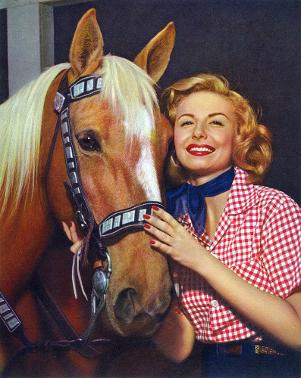
"The Prize Pair" - a calendar photo that was taken by Katie and Burt Owen in the mid 50s.
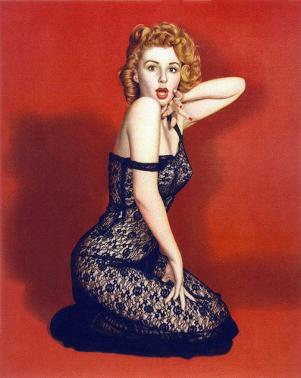
"For Goodness Sake!" - a pinup calendar photo by Katie and Burt Owen.
Regarding the couple's glamour and nude work: As mentioned earlier, the Winter 1960 edition of Modern Man Quarterly featured one of Katie and Burt's artistic nudes. The model in the photo looks very much like Jeanmarie Lussier to me, and it may very well be her. You can see the photo here (although you may have to rotate your head a bit to get a better view of her face).
At some point in the early to mid 60s, Katie and Burt retired from the photography business. I have seen the Anaheim telephone listings for Burt Owen throughout the 1950s and they had always listed his occupation as photographer, until 1960, when there was no mention of it. This might mean that 1960 was the year Katie and Burt retired, but then again, it might not. The Owens continued to live in Anaheim until 1969, when they moved to Modesto. In December of that year, more than a dozen of the couple's friends made the trip from Anaheim to Modesto to throw a surprise 40th anniversary party for Katie and Burt at a local restaurant (they had been married on Christmas Day 1929).
For some as yet unknown reason, after about a year of making their home in Modesto, the couple moved back to Anaheim and lived there for many more years. In 1984, Katie and Burt once again moved to Modesto, where they would remain for the rest of their lives.
Katherine Owen passed away on April 23, 1992 at the age of 81. Perry Burton Owen passed just over two years later (June 2, 1994) at English Oaks Convalescent Hospital in Modesto. He was 84. Both had elected to be cremated and have their ashes scattered at sea off the coast of Santa Cruz, CA. The couple had no children.
Note: I am always on the lookout for more of Katie and Burt's work, so if any readers come across some of their photos, please let me know. In my attempt to locate several of the color pinups that were sold to calendar companies from 1945 to 1960, I did end up finding six of them that were bought by the Goes Lithographing Co. (Delavan, WI) and I purchased two 8x10 prints. The company sells lithographs of Katie and Burt's work on Etsy here.
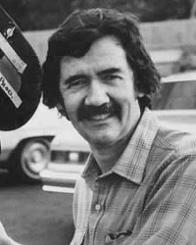
Glenn Otto - Glenn Otto was a photographer who shot some glamour in the early to late 60s and in 1961 or '62 he photographed a beautiful brunette named Merissa Mathes who would be chosen to become Playboy's Playmate of the Month for June 1962. Glenn would later have some of his glamour work published in the November 1965 issue of Modern Man magazine and the May 1965 issue of Caper magazine.
Glenn Allen Otto was born on May 1, 1932 in Eureka, California to Edgar Allen Otto (who worked as a manager in auto sales and service) and Clarice Marie Getchell Otto, a school teacher. After high school, Glenn attended the University of California at Berkeley and upon graduation he moved to Los Angeles and enrolled in the Fred Archer School of Photography. Sometime after completing his course of study at the Fred Archer school, Glenn opened his own studio in Los Angeles in 1958 or '59. His first studio was located at 5913 Hollywood Blvd, but by 1960 he had moved to his new location at 7325 Melrose Ave. While at this address, Glenn discovered and photographed Merissa Mathes and his photos of her were selected by Hugh Hefner to appear in the June 1962 issue of Playboy magazine. Merissa went on to take small roles in several TV shows during the mid-60s and also appeared in a few movies. You can see two of Glenn's excellent images of Merissa here.
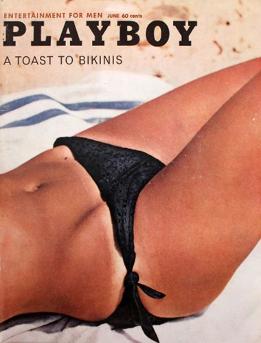
The June 1962 issue of Playboy magazine which featured Merissa Mathes' Playmate pictorial.
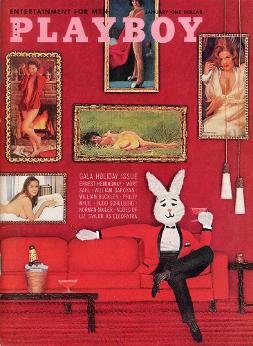
The January 1963 issue of Playboy which featured Glenn Otto's centerfold of Merissa Mathes on the cover (she's lying in the grass).
By 1964, Glenn had moved his studio location yet again, this time to 7408 Beverly Blvd, where he would remain for many years to come. During the 60s, Glenn seemed to concentrate on shooting both fashion and glamour and one of his other glamour models, Christy Leigh, would be featured in the Doll of the Month section of the November 1965 issue of Modern Man. Christy had come to Los Angeles from Amarillo, Texas and was working as a receptionist for a large insurance company when Glenn discovered her.
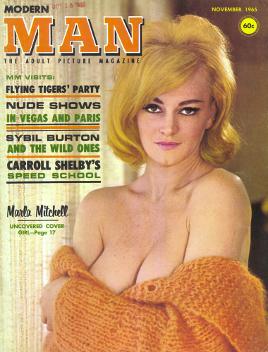
The Nov. 1965 issue of Modern Man which featured Glenn Otto's photos of model Christy Leigh in the Doll of the Month section.
In the 1970s and 80s, Glenn shifted his focus and began working in the field of advertising photography and in the 1990s, he transitioned into selling real estate in the Los Angeles area, an occupation which he particularly enjoyed.
Concerning his personal life, Glenn married Virginia Robertson on June 14, 1952 in Sacramento, California and the two would have three children during their 33 years of marriage.
After Glenn Otto retired from the real estate business, he would eventually begin to suffer from Alzheimer's disease, which contributed to his death on July 10, 2012 in Los Angeles. He was 80 years old and was survived by his three children, Steven Otto, Karen Edelman, and David Otto. Glenn was buried in Santa Barbara, CA near his parents' graves (in Santa Barbara Cemetery).
